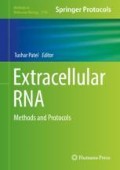Abstract
Exosomes represent one class of extracellular vesicles that are thought to be shed by all cell types. Although the exact nature of exosome biogenesis and function remains incompletely understood, they are increasingly recognized as a source of intercellular communication in health and disease. Recent observations of RNA exchange via donor cell-derived exosomes that exert genetic regulation in recipient cells have led to a boon into exosome research. The excitement and promise of exosomes as a new therapeutic avenue for human pathologies remain limited by challenges associated with their isolation from culture media and biofluids. The introduction of new methodologies to facilitate the isolation of exosomes has simultaneously raised concerns related to the reproducibility of studies describing exosome effector functions. Even high-speed ultracentrifugation, the first and long considered gold standard approach for exosome isolation has recently been noted to be subject to uncontrolled variables that could impact functional readouts of exosome preparations. This chapter describes principles and methods that attempt to overcome such limitations by first concentrating exosomes in a liquid cushion and subsequently resolving them using density gradient ultracentrifugation. Our approach avoids possible complications associated with direct pelleting onto plastic tubes and allows for further purification of exosomes from dense protein aggregates.
Access this chapter
Tax calculation will be finalised at checkout
Purchases are for personal use only
References
Colombo M, Raposo G, Thery C (2014) Biogenesis, secretion, and intercellular interactions of exosomes and other extracellular vesicles. Annu Rev Cell Dev Biol 30:255–289
Valadi H, Ekstrom K, Bossios A, Sjostrand M, Lee JJ, Lotvall JO (2007) Exosome-mediated transfer of mRNAs and microRNAs is a novel mechanism of genetic exchange between cells. Nat Cell Biol 9:654–659
Yanez-Mo M, Siljander PR, Andreu Z, Zavec AB, Borras FE, Buzas EI, Buzas K, Casal E, Cappello F, Carvalho J et al (2015) Biological properties of extracellular vesicles and their physiological functions. J Extracell Vesicles 4:27066
Gyorgy B, Hung ME, Breakefield XO, Leonard JN (2015) Therapeutic applications of extracellular vesicles: clinical promise and open questions. Annu Rev Pharmacol Toxicol 55:439–464
Kourembanas S (2015) Exosomes: vehicles of intercellular signaling, biomarkers, and vectors of cell therapy. Annu Rev Physiol 77:13–27
Johnstone RM, Adam M, Hammond JR, Orr L, Turbide C (1987) Vesicle formation during reticulocyte maturation. Association of plasma membrane activities with released vesicles (exosomes). J Biol Chem 262:9412–9420
Thery C, Amigorena S, Raposo G, Clayton A (2006) Isolation and characterization of exosomes from cell culture supernatants and biological fluids. Curr Protoc Cell Biol. Chapter 3:Unit 3.22
Linares R, Tan S, Gounou C, Arraud N, Brisson AR (2015) High-speed centrifugation induces aggregation of extracellular vesicles. J Extracell Vesicles 4:29509
Momen-Heravi F, Balaj L, Alian S, Mantel PY, Halleck AE, Trachtenberg AJ, Soria CE, Oquin S, Bonebreak CM, Saracoglu E et al (2013) Current methods for the isolation of extracellular vesicles. Biol Chem 394:1253–1262
Nordin JZ, Lee Y, Vader P, Mager I, Johansson HJ, Heusermann W, Wiklander OP, Hallbrink M, Seow Y, Bultema JJ et al (2015) Ultrafiltration with size-exclusion liquid chromatography for high yield isolation of extracellular vesicles preserving intact biophysical and functional properties. Nanomedicine 11:879–883
Abramowicz A, Widlak P, Pietrowska M (2016) Proteomic analysis of exosomal cargo: the challenge of high purity vesicle isolation. Mol Biosyst 12:1407–1419
Van Deun J, Mestdagh P, Agostinis P, Akay O, Anand S, Anckaert J, Martinez ZA, Baetens T, Beghein E, Bertier L et al (2017) EV-TRACK: transparent reporting and centralizing knowledge in extracellular vesicle research. Nat Methods 14:228–232
Elmowalid GA, Qiao M, Jeong SH, Borg BB, Baumert TF, Sapp RK, Hu Z, Murthy K, Liang TJ (2007) Immunization with hepatitis C virus-like particles results in control of hepatitis C virus infection in chimpanzees. Proc Natl Acad Sci U S A 104:8427–8432
Greening DW, Xu R, Ji H, Tauro BJ, Simpson RJ (2015) A protocol for exosome isolation and characterization: evaluation of ultracentrifugation, density-gradient separation, and immunoaffinity capture methods. Methods Mol Biol 1295:179–209
Lamparski HG, Metha-Damani A, Yao JY, Patel S, Hsu DH, Ruegg C, Le Pecq JB (2002) Production and characterization of clinical grade exosomes derived from dendritic cells. J Immunol Methods 270:211–226
Lobb RJ, Becker M, Wen SW, Wong CS, Wiegmans AP, Leimgruber A, Moller A (2015) Optimized exosome isolation protocol for cell culture supernatant and human plasma. J Extracell Vesicles 4:27031
Acknowledgments
This work was supported by grants from the American Heart Association ( 16GRNT27640007), National Institutes of Health; (5U19CA179512) Extracellular RNA Communication Consortium Common Fund, and HL133575 to (R.L.R.) which was administered by the Northern California Institute for Research and Education. The work was performed at the Veterans Affairs Medical Center, San Francisco, CA.
Author information
Authors and Affiliations
Corresponding author
Editor information
Editors and Affiliations
Rights and permissions
Copyright information
© 2018 Springer Science+Business Media, LLC
About this protocol
Cite this protocol
Li, K., Wong, D.K., Hong, K.Y., Raffai, R.L. (2018). Cushioned–Density Gradient Ultracentrifugation (C-DGUC): A Refined and High Performance Method for the Isolation, Characterization, and Use of Exosomes. In: Patel, T. (eds) Extracellular RNA. Methods in Molecular Biology, vol 1740. Humana Press, New York, NY. https://doi.org/10.1007/978-1-4939-7652-2_7
Download citation
DOI: https://doi.org/10.1007/978-1-4939-7652-2_7
Publisher Name: Humana Press, New York, NY
Print ISBN: 978-1-4939-7651-5
Online ISBN: 978-1-4939-7652-2
eBook Packages: Springer Protocols

